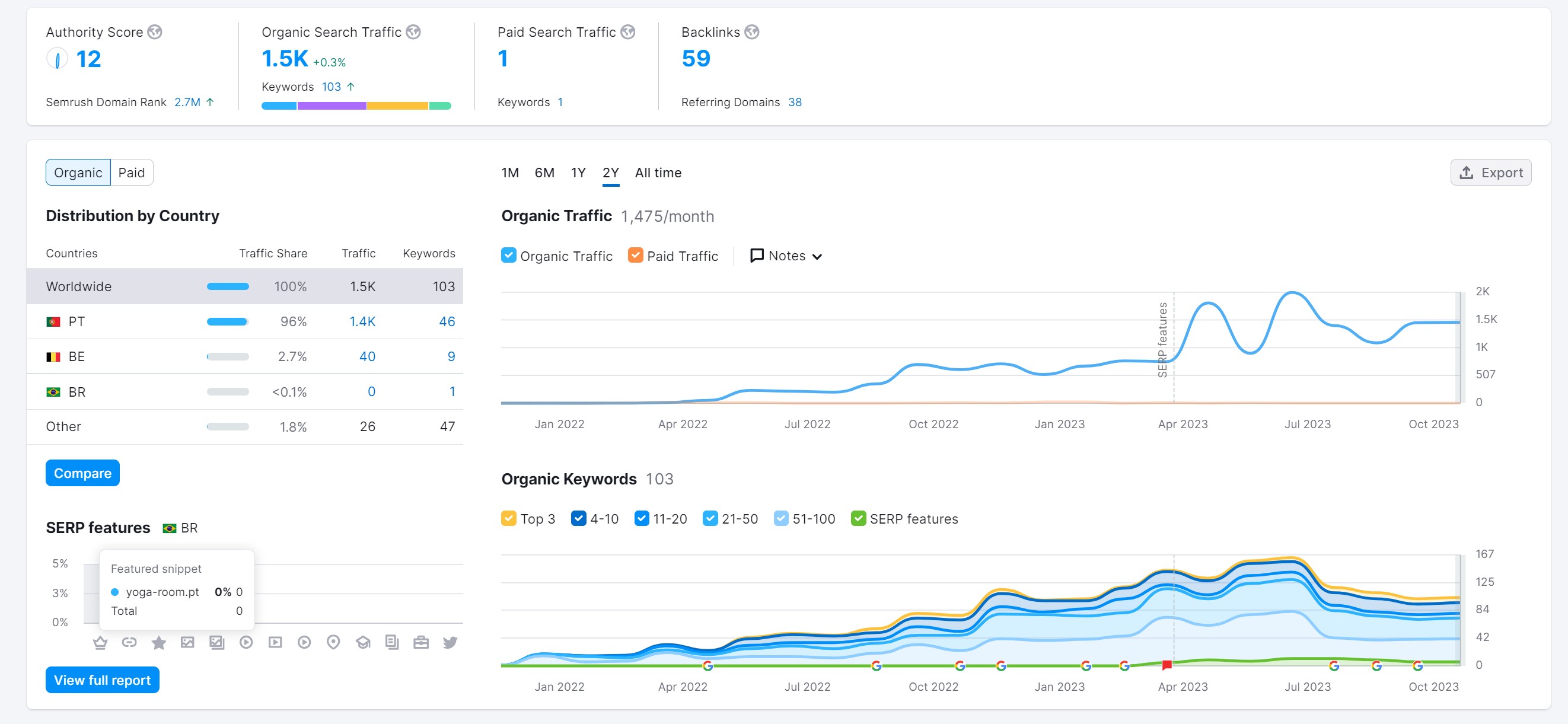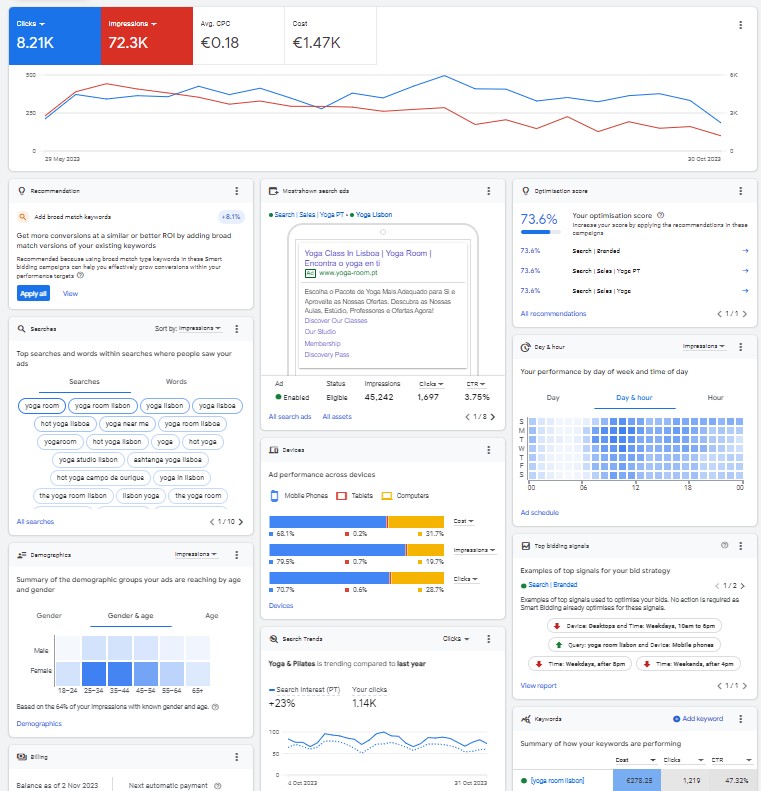4 min to read
Goals
The primary goal of Yoga Room was to establish itself as a premier yoga studio in Lisbon. Being a new entrant in a saturated market with established yoga studios, they aimed for quick brand awareness and customer acquisition. The objectives included:
- Building brand recognition and reputation.
- Attaining full class registration within two months.
- Pre-selling a significant number of monthly subscriptions even before the completion of their studio.
- Differentiating themselves from competitors in the market.
Target
Our target audience encompassed health-conscious individuals within Lisbon looking to either begin or continue their yoga journey. They range from novices to advanced yoga practitioners, aged between 20 to 50 years, both male and female, who value wellness, personal growth, and a sense of community.
Personas Within the Target
- Ana, the Beginner: A 25-year-old recent graduate who's new to yoga. She's looking to improve her flexibility and manage stress from her new job.
- Ricardo, the Busy Professional: 35 years old, a tech executive who spends most of his time sitting. He's searching for an activity to improve posture, physical health, and detach from work.
- Marta, the Advanced Yogi: A 28-year-old who's practiced yoga for five years. She's looking for advanced classes and possibly, teacher training courses.
- Luis, the Fitness Enthusiast: 30 years old, regularly hits the gym, and wants to integrate yoga for better flexibility and muscle recovery.
- Clara, the Expecting Mother: 33 years old, pregnant with her first child. She’s looking for prenatal yoga classes to prepare her body and mind for childbirth.
Using Digital Marketing to Reach These Personas
-
SEO and Content Marketing:
- Strategy: Create a blog on the Yoga Room website featuring articles catering to each persona. Topics could include "Beginner Yoga Tips" for Ana or "Benefits of Prenatal Yoga" for Clara.
- Justification: These will drive organic traffic and position Yoga Room as an authority in the yoga space in Lisbon.
-
Pay-per-Click (PPC) Advertising:
- Strategy: Use the data from the provided analytics to bid on keywords relevant to our personas like "yoga for beginners" or "prenatal yoga classes."
- Justification: This ensures that Yoga Room ads appear when our personas actively search for yoga classes.
-
Social Media Marketing:
- Strategy: Create engaging video content, such as short yoga sequences or testimonials. Segment the audience to show tailored ads; for instance, show prenatal yoga sequences to expecting mothers.
- Justification: Leveraging platforms like Instagram or Facebook, where visuals dominate, can captivate potential clients and showcase the Yoga Room experience.
-
Email Marketing:
- Strategy: Design a drip email campaign for individuals who show interest or sign up on the website. Offer them insights, tips, and exclusive deals.
- Justification: Keeps the Yoga Room brand at the top of their mind and encourages them to complete the sign-up process.
-
Affiliate and Partnership Marketing:
- Strategy: Collaborate with health cafes, wellness spas, and gyms in Lisbon for mutual promotions.
- Justification: Tapping into the existing customer base of complementary businesses can bring in a flux of new clients.

Paid Advertising Data
Overall Metrics:
- Clicks: The ad campaign received a total of 8.21K clicks.
- Impressions: The campaign made 72.3K impressions, meaning it appeared that many times to users.
- Average Cost-Per-Click (Avg. CPC): The average cost incurred for each click was €0.18.
- Total Cost: The total expenditure for the campaign was €1.47K.
Trends Over Time:
There's a downward trend in both clicks and impressions over the time period shown. This suggests that over time, the ads are being seen and clicked on less frequently.
While both metrics are declining, the rate of decline in clicks appears steeper than that of impressions.
Keyword Analysis:
The top search terms triggering the ads include 'yoga room', 'yoga room lisbon', and 'yoga lisboa'. Understanding these keywords can help refine targeting and optimize ad copy.
Demographics:
The majority of users interacting with the ads fall within the 18-34 age bracket, with a significantly smaller percentage in the 35-44 age range.
The campaign appears to be more effective among female users.
Devices:
The campaign is predominantly viewed on mobile phones (81.1% of impressions) compared to computers (9.5%) and tablets (9.4%).
Trending:
Yoga & Pilates have seen a 23% increase in trend over the last year, suggesting a growing market.
SEO Data
Website Metrics:
- Authority Score: 12 - This score measures the overall quality of a domain and its influence in terms of backlinks and trust.
- Organic Search Traffic: 1.5K, with a slight positive growth of +0.3%.
- Backlinks: The website has 59 backlinks from 38 referring domains.
Geographic Distribution:
- 96% of the traffic comes from Portugal (PT) followed by Belgium (BE) at 2.7%.
Organic Traffic Trend:
- There's a steady increase in organic traffic starting from October 2022, indicating improved search rankings or more search volume for relevant keywords.
Keyword Rankings:
- The website ranks for 103 keywords with varying positions. Ensuring these keywords are optimized can lead to better rankings and more traffic.

Ad Details:
- The ad 'Yoga Class in Lisboa | Yoga Room' has a click-through rate (CTR) of 3.75% based on 45,424 impressions. This CTR is considered good, suggesting the ad copy and targeting are effective.
Device Performance:
- Consistent with earlier data, mobile phones are the leading device for ad interactions.
Trending:
- The search interest for 'yoga room lisboa' and similar terms appears to fluctuate, but there's a notable spike around September and October.
Keyword Performance:
- The keyword 'yoga room lisboa' has cost €275.29 but garnered 4,972 clicks, suggesting it's a high-performing keyword for the campaign.
Conclusions & Recommendations:
- Paid Advertising: It might be beneficial to explore why there's a decline in both clicks and impressions. Adjusting targeting, refreshing ad creatives, or optimizing landing pages could help.
- SEO: Continue optimizing the website for organic search, focusing on the 103 keywords identified. Since most traffic is from Portugal, ensure the content is regionally relevant.
- Devices: Given the dominance of mobile interactions, ensure the website and landing pages are mobile-optimized to enhance user experience.
- Keyword Strategy: For both paid and organic, continue monitoring and optimizing for the top-performing keywords like 'yoga room lisboa'.
- Overall, the data suggests that there's a solid foundation for both paid and organic strategies. Regularly revisiting and optimizing these strategies can further enhance results.



Add comment ×